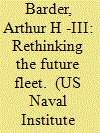| Srl | Item |
| 1 |
ID:
090929


|
|
|
|
|
| Publication |
2009.
|
| Summary/Abstract |
The Maritime Military School System, with its mission to have future officers up and ready to serve on combat ships of the Polish Navy, has been in operation for nearly 90 years. This School System was first introduced in 1921 and although it has, over all these years, undergone numerous changes, its mission remains just the same - to foster new generations of Polish best naval officers. Its hitherto existence may be divided into four main periods: (a) from 1921 through 1939, encompassing the time of efforts to prepare sufficient cadres for the rising maritime and river flotillas. Those efforts, however strenuous, proved fruitful and brought us officers whose professionalism evidenced itself during WWII hostilities at seas and oceans; (b) from 1939 through 1945 - when the Polish Maritime Military School System operated in exile, most notably in the United Kingdom. It's graduates excelled at warfare and won acclaim from the leadership of the Allied Forces; (c) from 1946 through 1991, epitomized by incessant changes with a view to modernize educational and training processes and address requirements of the theater of operations. Good sense of direction behind those changes is evident and confirmed by our allies - the NATO members; (d) which has continued since and featured political transformation and alignment with NATO. And once again the School System yields acclaimed cadres who, in turn, may take pride in serving under the white and red flag.
|
|
|
|
|
|
|
|
|
|
|
|
|
|
|
|
| 2 |
ID:
130756


|
|
|
|
|
| Publication |
2014.
|
| Summary/Abstract |
The U.S. Navy has no overall requirements process for designing a Fleet, and it needs one-desperately.
The Navy finds itself caught in the perfect storm between the cost constraints of the national budget environment and the capability demands of globally proliferating counter-naval technologies. At present projected budget levels, if we continue our current processes for setting the design requirements of future ships and aircraft, the service's size will shrink over the next two decades to about two-thirds of today's force-structure goals of 306 ships and 3,000 aircraft. Unless we find more efficient ways to generate forward deployments out of this fleet, the Navy's forward posture-its key contribution to national strategy and joint U.S. military capability-will shrink to far less than the 100 deployed ships typically used to deliver global capability. This is not the right path.
It is time to rethink how we will design the future Fleet in a way that rebalances affordability, platform capability, and deployment processes. We must build it as a whole instead of continuing to "let it happen" one platform requirements decision at a time.
|
|
|
|
|
|
|
|
|
|
|
|
|
|
|
|